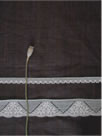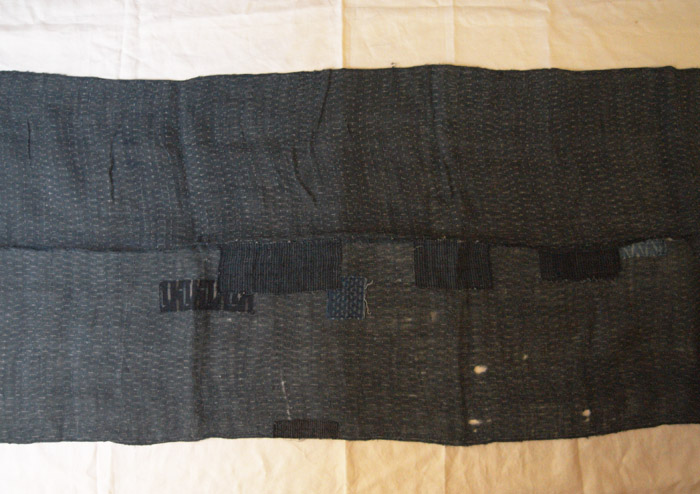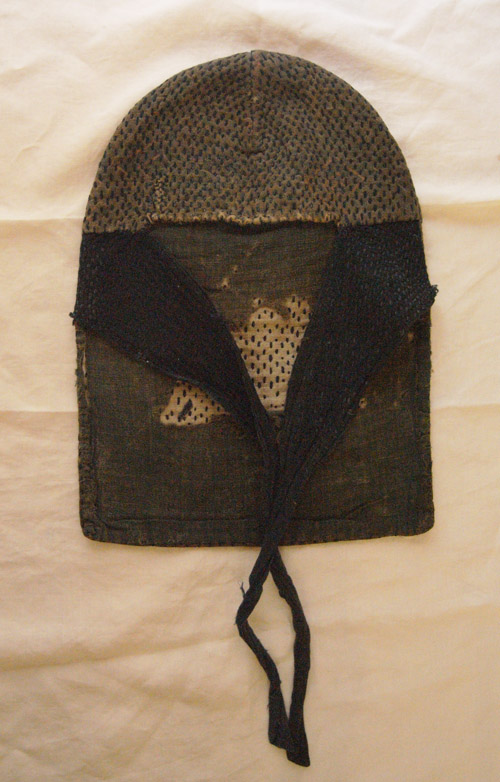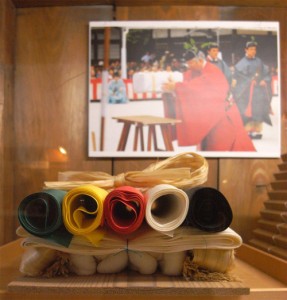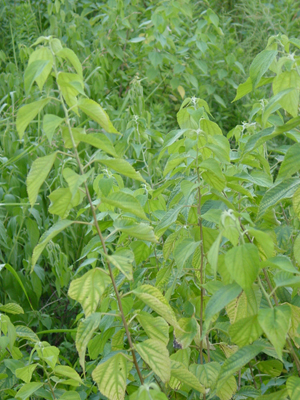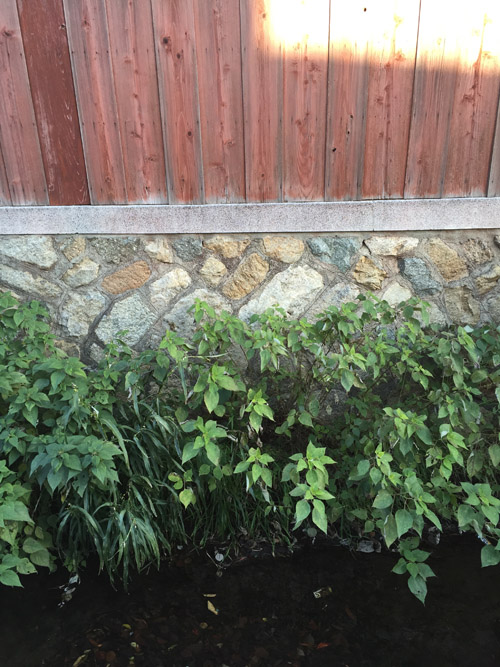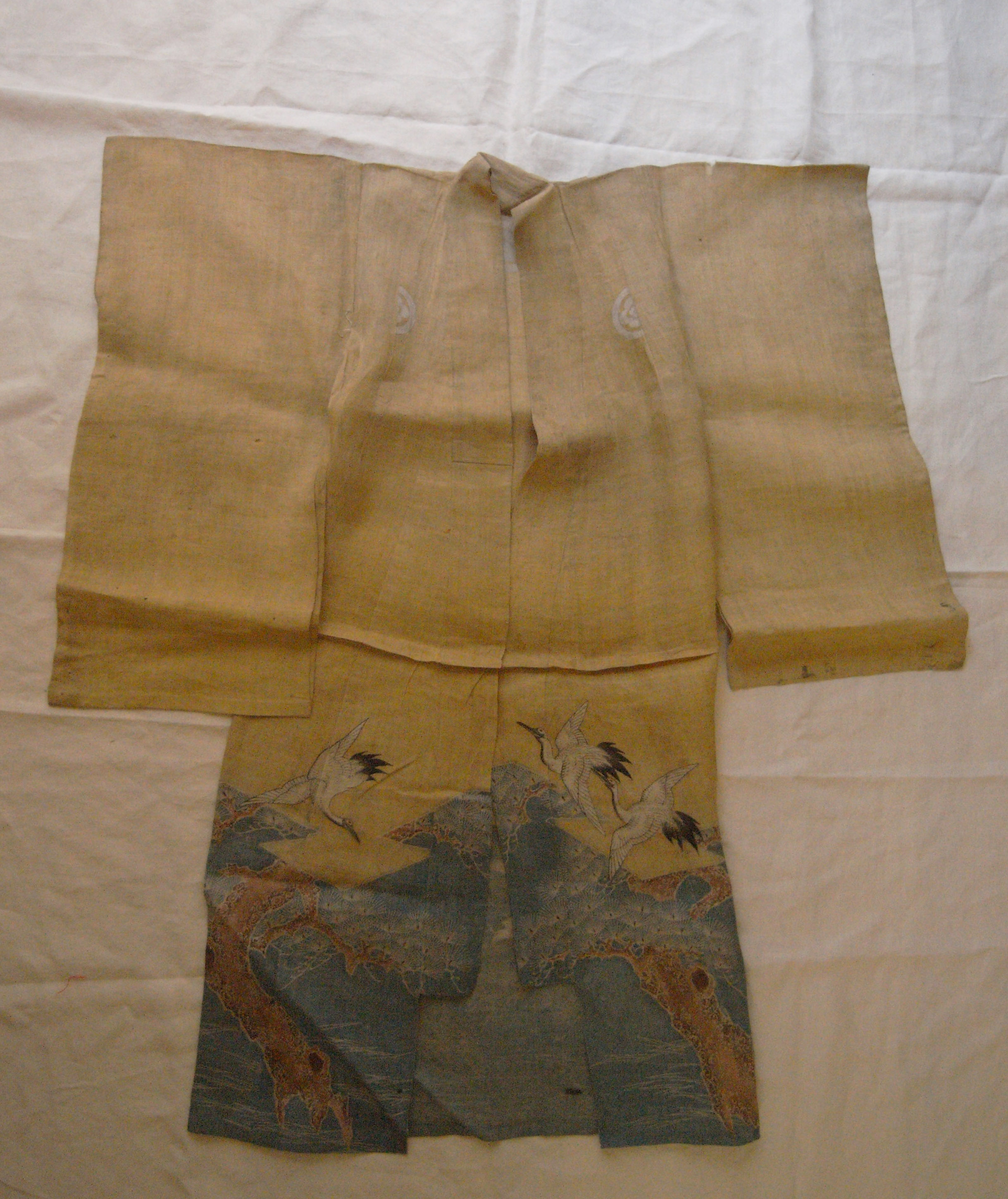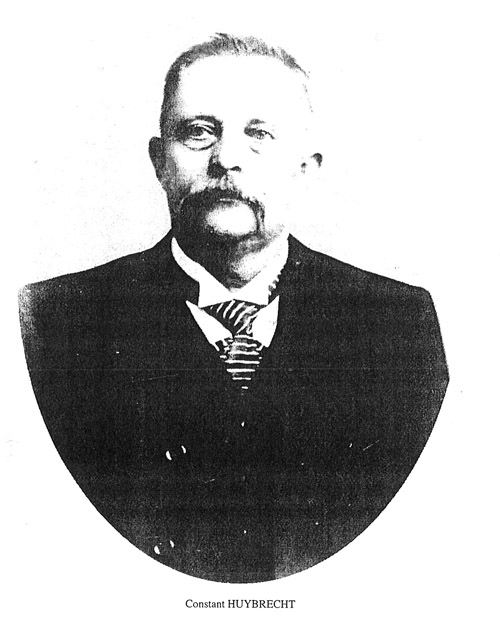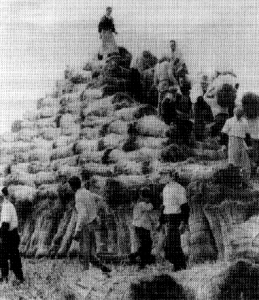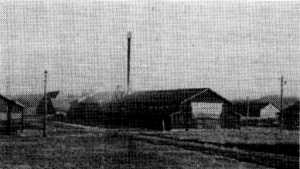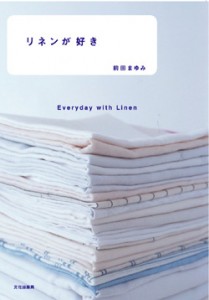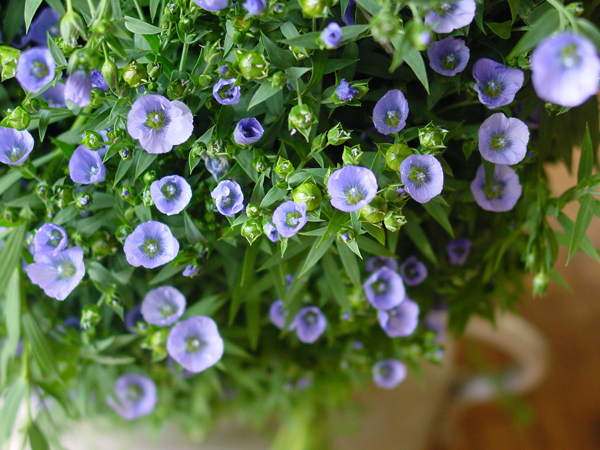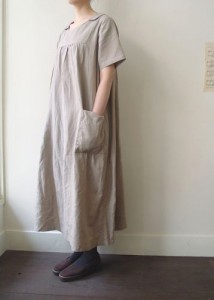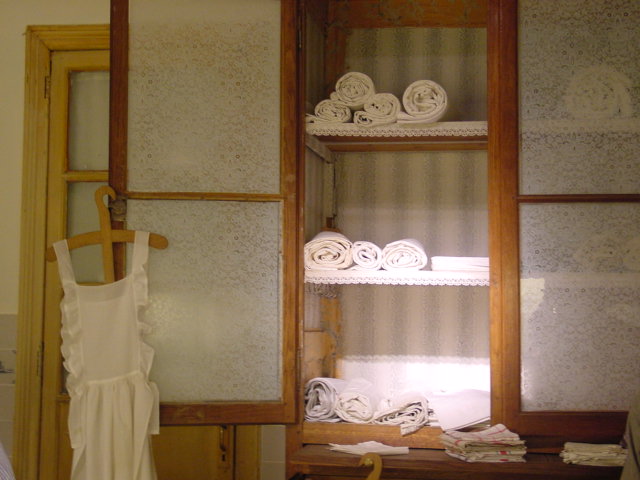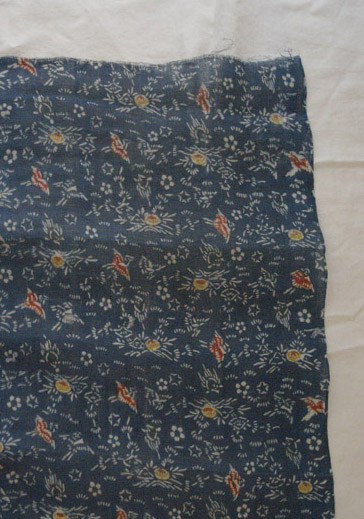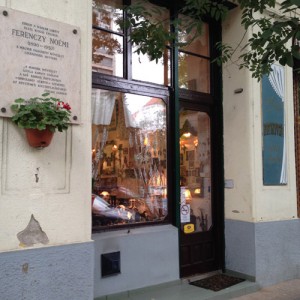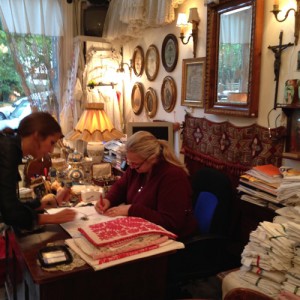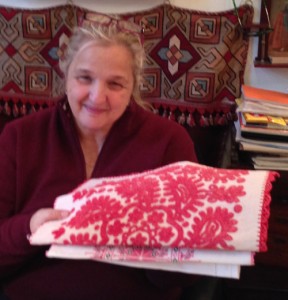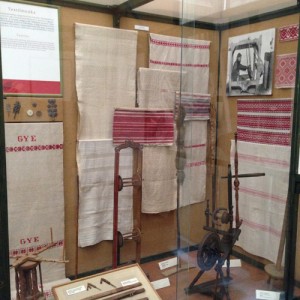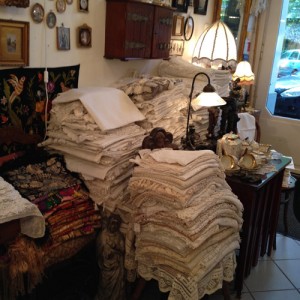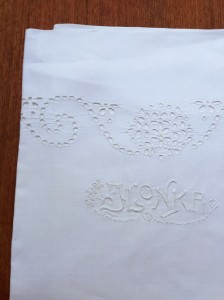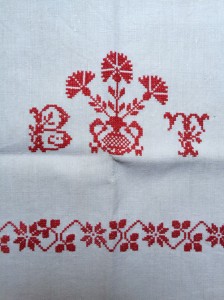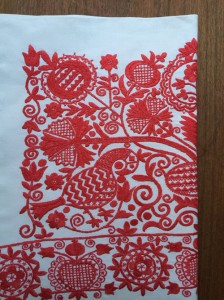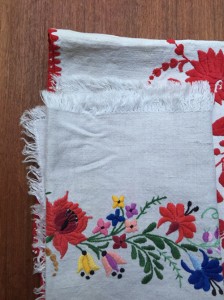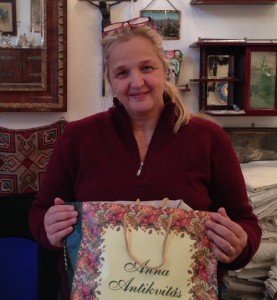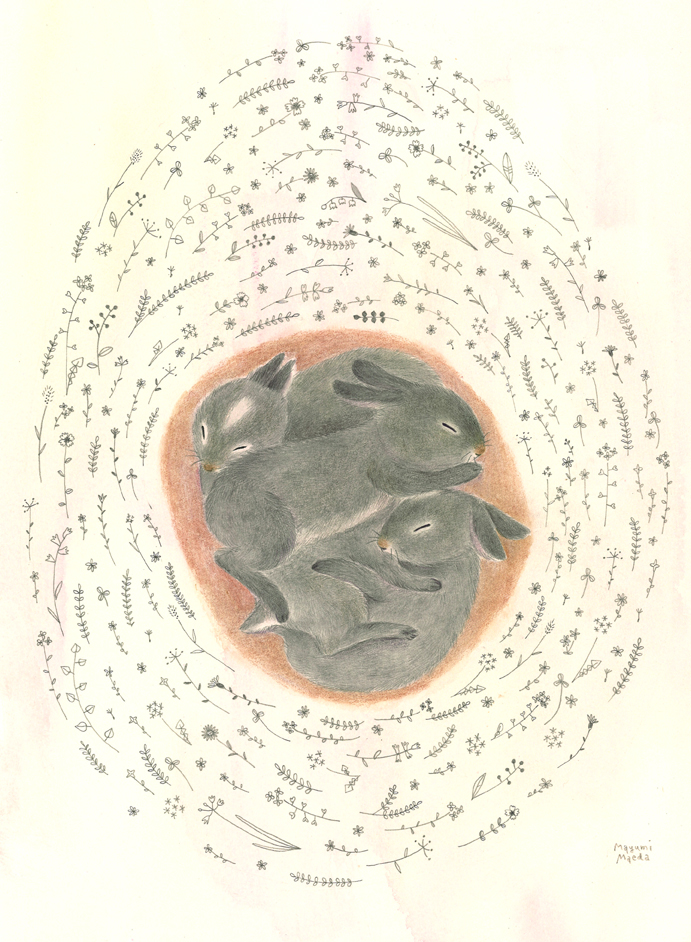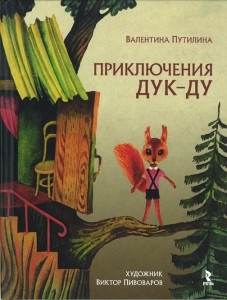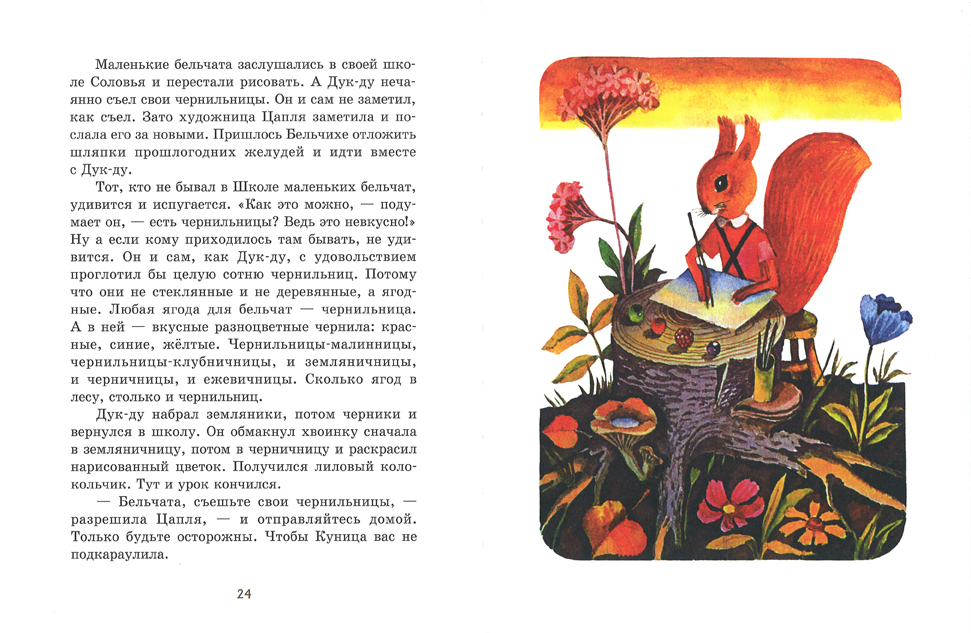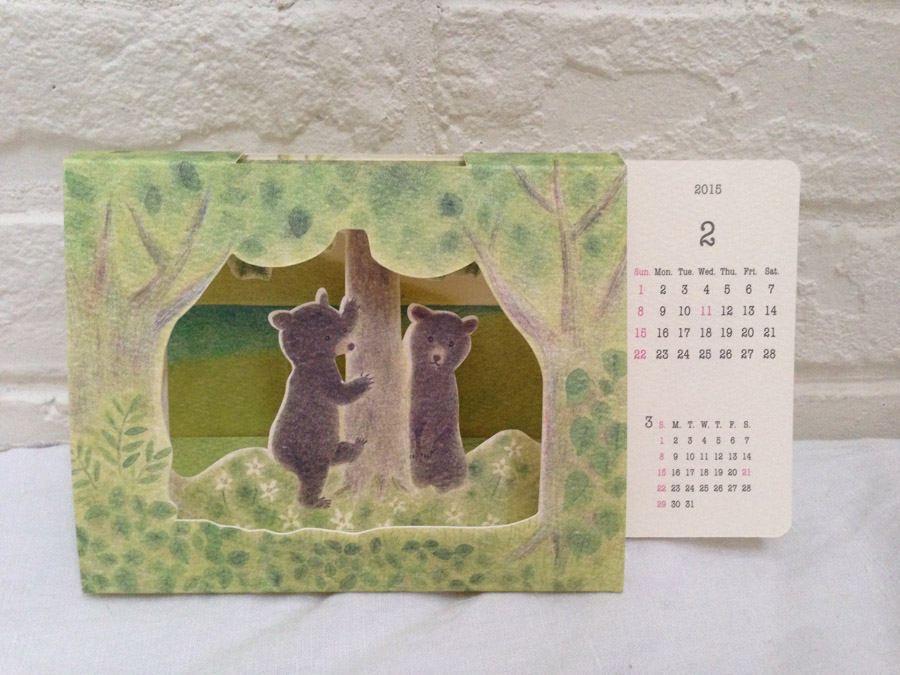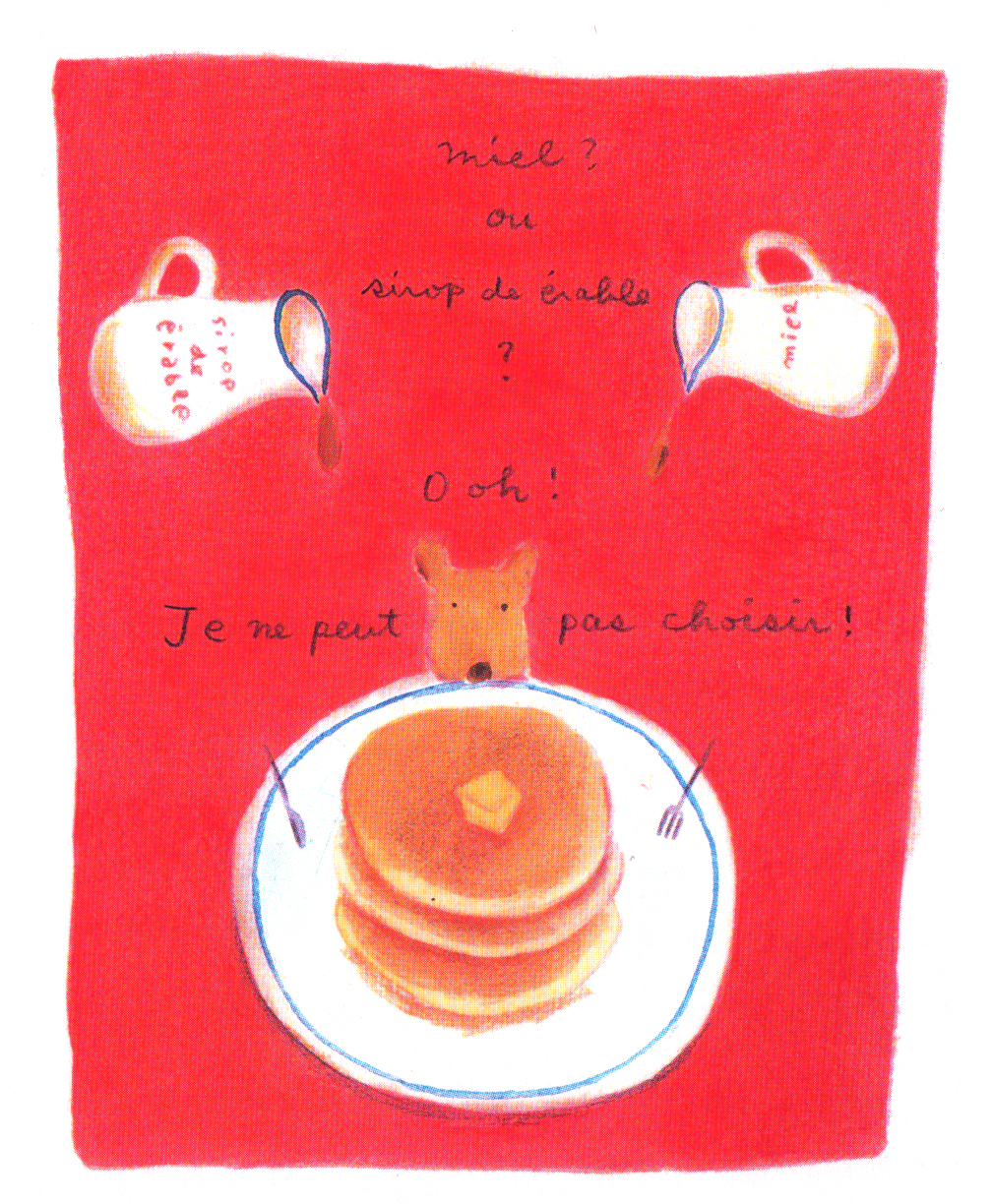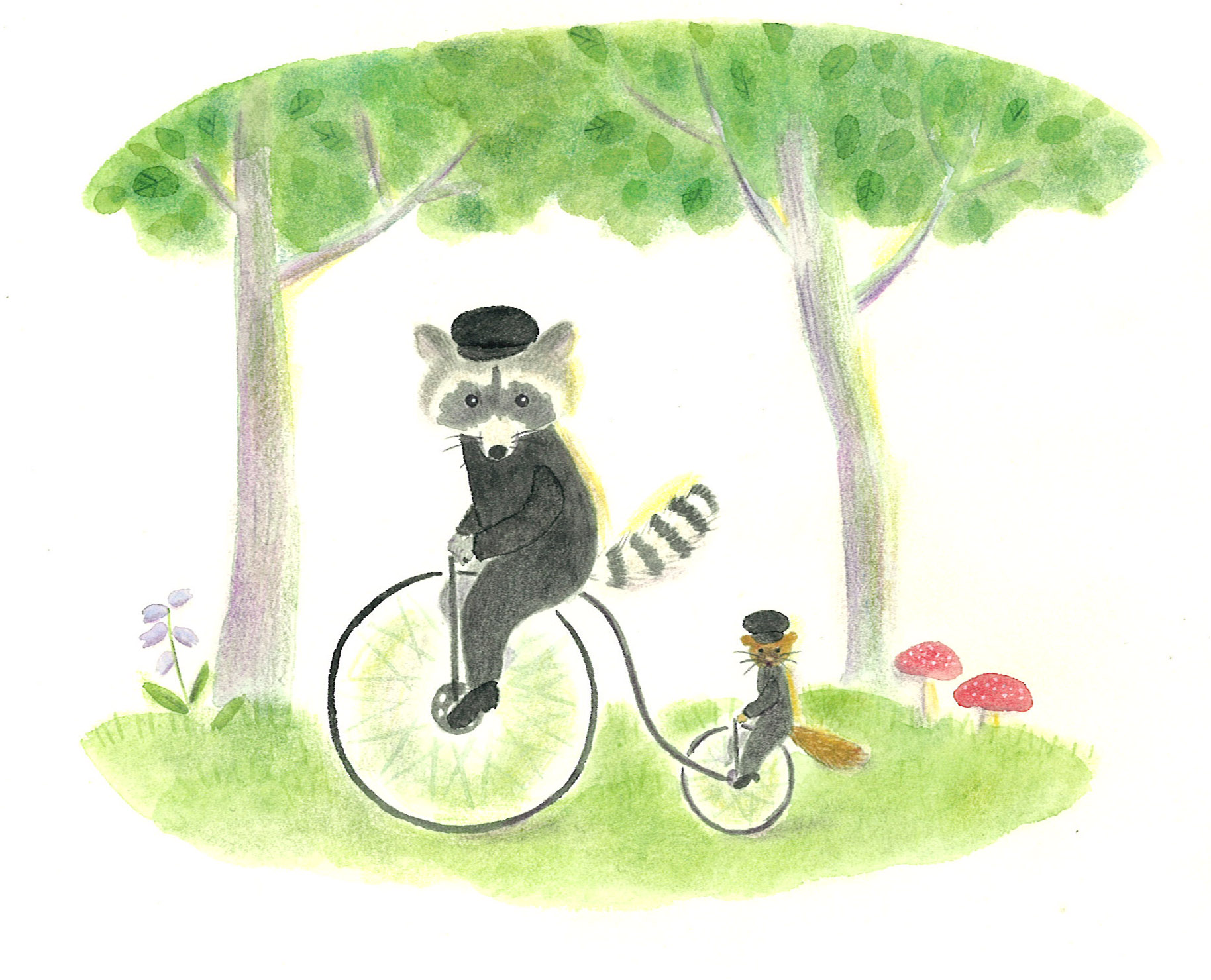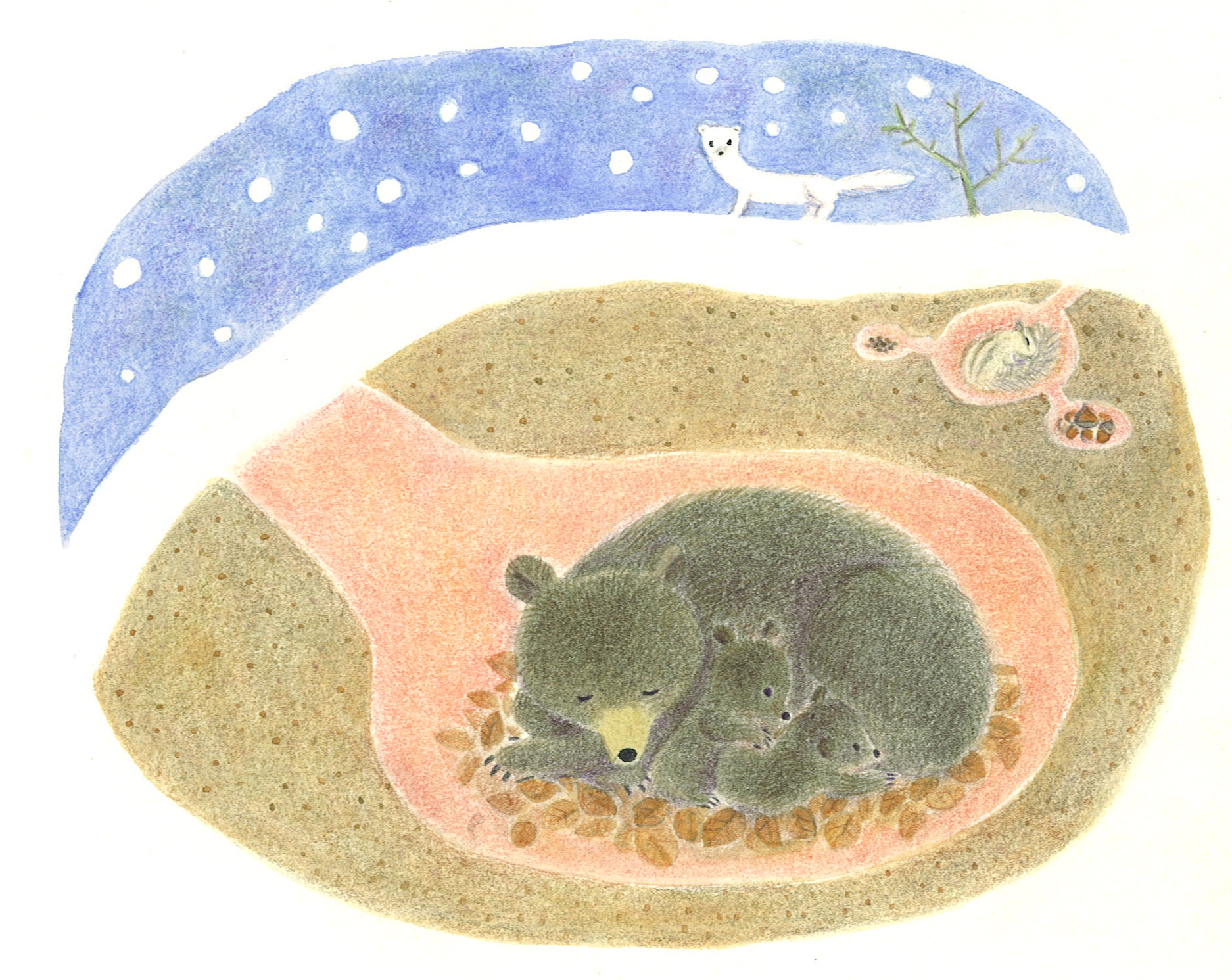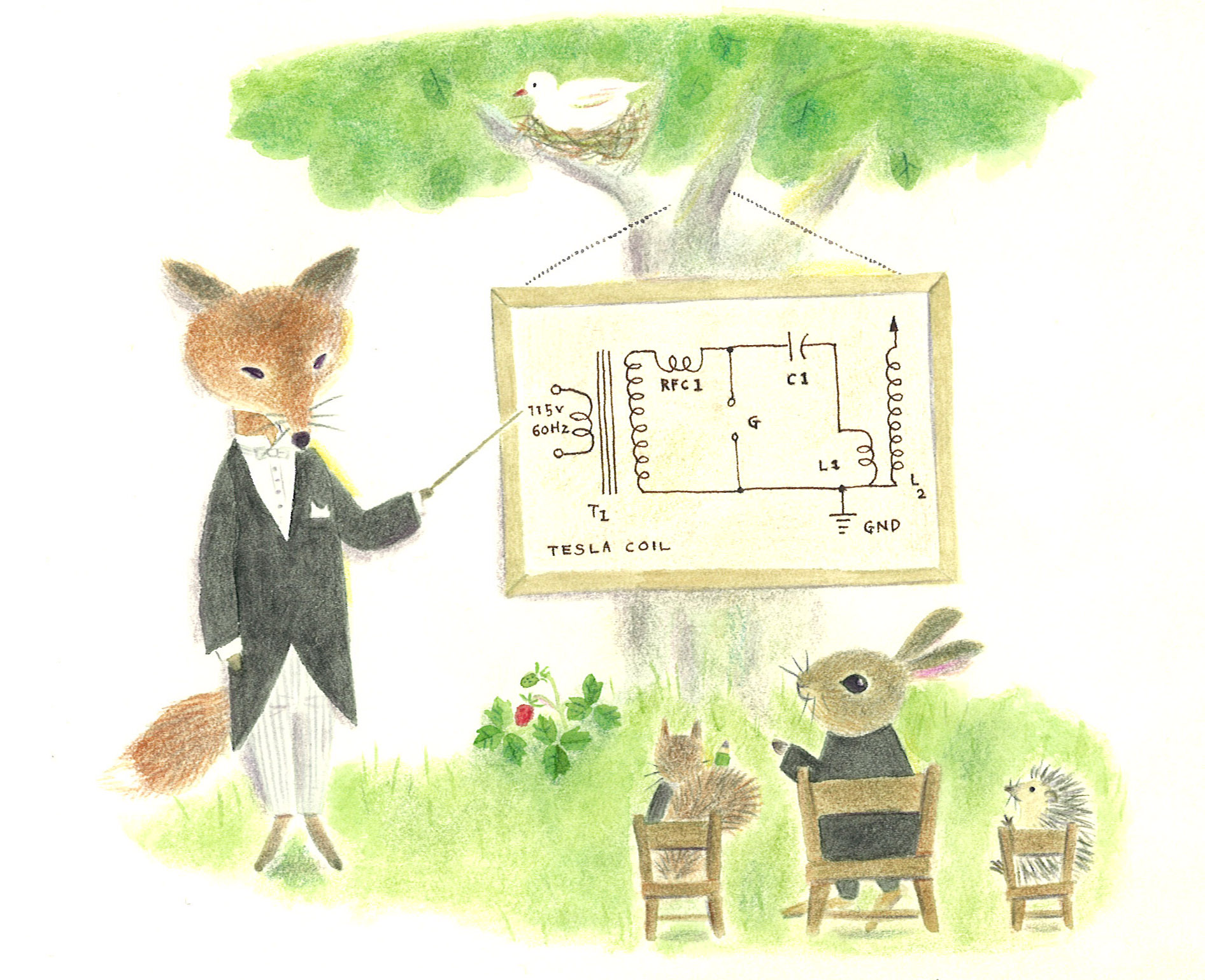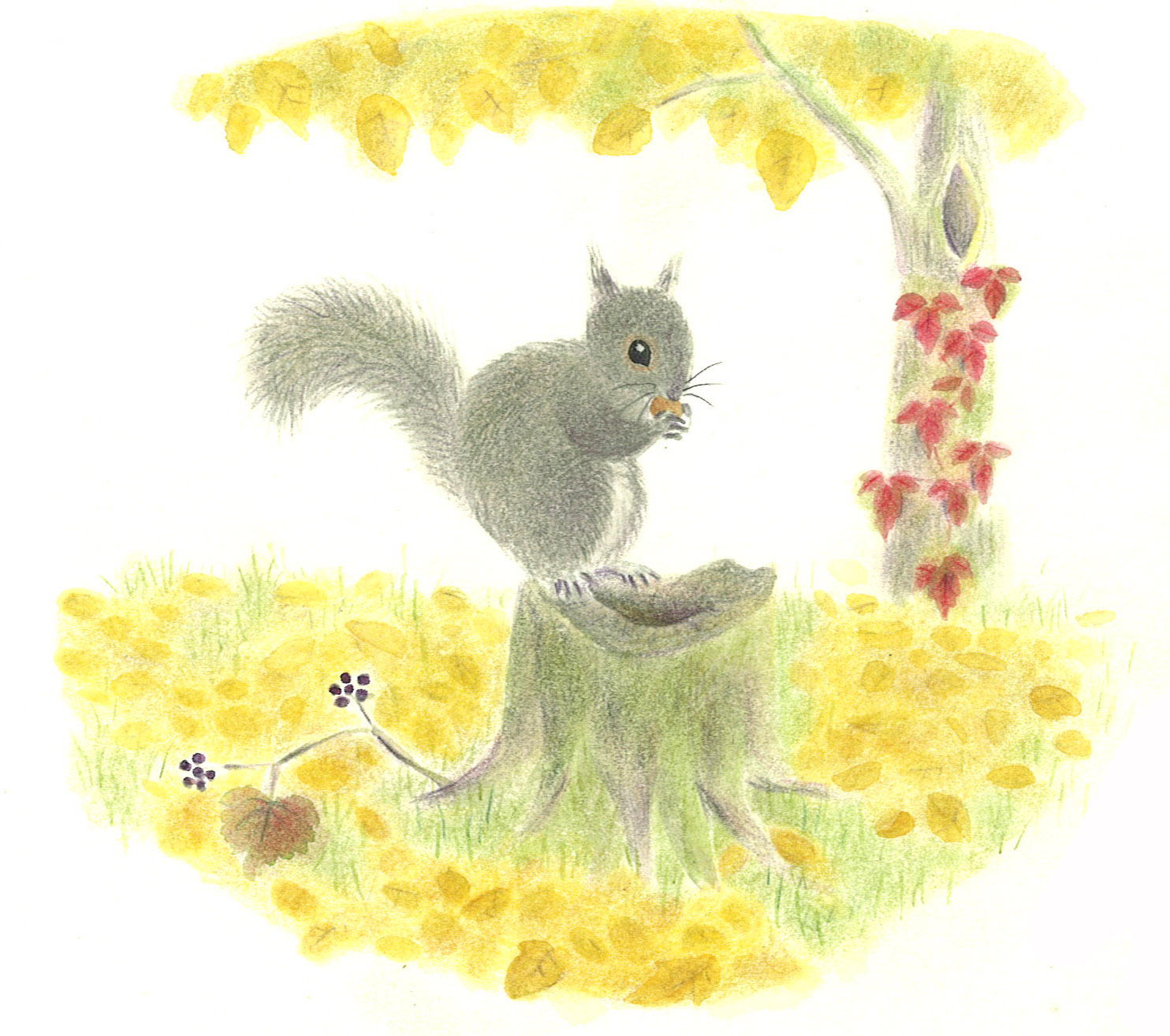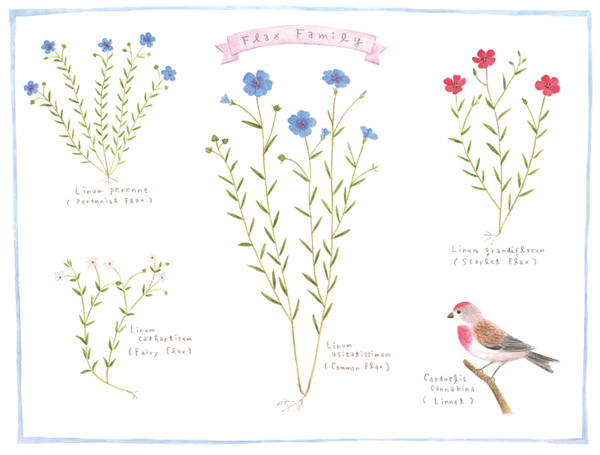* Bast Fibers in Japan
2014/11/22 | Filed under Linen | Tags bast fibers, hemp, Linen, ramie, textile history.In 2009, I made a presentation about ‘Asa’ (= bast fibers in Japanese )at Artextrina conference held at University of Leeds in UK.
Now I am trying to brief its context adding some more images, as I hope it could be some reference for some colleagues from linen industry or textile historian (with apology for this belated upload to my colleague at Artextrina who requested this written form )
*********
In Japanese, we have a term ‘asa’ ‘麻’ which means ‘bast fibers’.
When we say ‘asa’ , there are several different plant variations; hemp, ramie, linen, kuzu-fu (葛布、Kuzu is pea family, Pueraria lobata), Basho-fu (芭蕉布 Basho is a plant belongs to the same family as banana, Musa basjoo) and so on.It is said that there are nearly 20 species as material for bast fibers here in Japan.
Cotton is not included in ‘asa’ , instead we say ‘men’ or ‘momen’ to differentiate cotton.
Normally from the word ‘asa’, Japanese people can imagine the dry, natural and somewhat stiff fabric made from plant stalks. In ancient times, hemp and ramie were the most popular ‘asa’, but nowadays, linen has become the most popular ‘asa’ in Japan.
(The history of hemp in Japan)
(↑unbreached hemp cloth made in traditional way)
(↑old cloth likely to be indigo dyed hemp)
Hemp is not native to Japan, but from alcheologic studies it is said that hemp had been used in Japan already around one thousand B.C.. Hemp can be grown in any soil including poor soil, narrow mountain areas and in colder climates in northern parts of Japan.
(↑hood likely made with hemp cloth, from northern eastern part of Japan, where neither cotton nor ramie can be raised.)
It is used not only for clothing, but for rope, Kaya (蚊帳 =mosquito net), Noren (暖簾 = entrance curtain), zabuton (座蒲団= cushion) and the edging of Tatami (畳) flooring.
Hemp is also considered to be a holy plant in Japan. Firstly, hemp is important in Shinto (神道), which is an indigenous religion to Japan.
(↑Curtain with emblem in Shimogamo Shrine, should be made with hemp originally, but unknown material actually)
Shinto is considered an amalgam of several streams of folklore religions. Shinto is not based on a written doctrine, but based on the worship of nature and ancestors. That is to say, it consists of, respect to, and fear of, nature. As you can see in the photo, Shinto shrines are typically surrounded by trees and forests, with a large entrance gate called ‘Torii’ that designates the divine place from the common place.
Hemp is used to make the ceremonial clothing of Shinto priests, and for Nusa (幣 = a white fringed stick to be shaken in rituals). The emperor as the top archbishop of Shinto, dedicates hemp cloth to the shrine at the time of the major ritual.
↑hemp and silk clothes are the important alliterate in Shinto. The white clothes and the bunch of fiber are hemp.
The word ‘大麻‘taima’ which literally means hemp is also used to mean a talisman.
It is not clear how and why hemp gained the status of a holy plant in Shinto. We are tempted to imagine that the ancient Japanese Shamans used the psychoactive effect of the hemp plant to hear ‘the voice of gods’; such voices are central to the teachings of Shinto.
But it is not formally discussed in Japan, as we cannot find any written evidence.
Another interesting issue, as you know, the latin name of hemp is ‘Cannabis’ which is said to have its origin in Schytian or Trachian language. In Shinto, there is a word pronounced ‘Kamnabi’ (神無奈備) which means ‘the place of the gods’. It should be noted the pronunciation of ‘kamnabi’ is similar to ‘Cannabis’, but the exact relationship remains unclear.
( Hemp and Ramie)
In ancient Japan, ramie, called ‘Karamushi ‘(苧) was perhaps the second most popular crop for fiber production, following hemp. While hemp (Cannabis sativa) is a yearly crop, ramie (Boehmeria nivea) is perennial and easily found, sometimes abundant in wild habitats in Japan, except in northern areas.
I have mentioned that hemp was considered a divine plant, but to the contrary ramie has never gained such a kind of holy character, instead regarded as a naturally occurring , ‘easy to access ‘plant.
(↑Karamushi(ramie) growing in wild , along riverbank and small waterway of my neighbor in Kyoto)
However, these 2 materials have been variously confused throughout Japanese history. This ambiguity mainly derives from the fact that hemp and ramie fabrics look similar to each other.
Or sometimes no clear discrimination for the material was required actually at that time, because sometimes hemp and ramie were used together to make one fabric, like warp from hemp, or weft from ramie .
By the 7th century, the ancient government had established rule over mainland Japan, and had introduced a taxation system called So-yo-cho(租庸調). In ancient tax records, vegetable fibers including hemp and ramie were sometimes indicated by the term ‘nuno’ (布), which simply means ‘fabric’ nowadays.
Thus, by the term ‘nuno’, it was impossible to identify which material it was made from, just like our modern term ‘asa’.
By the middle ages, some of those regions had established a reputation for their ‘asa’ production.
At the same time, ramie or hemp fiber ‘Ao-so’ (literally means,Green hemp or green ramie) was in wide distribution. This fiber was sold at markets in big cities, so city residents who could not raise their own crops, were able to obtain raw material to make yarns and clothes by themselves. It must have been a good way for farmers to get income, and for city residents, it must have been a good way to save on the cost of their clothing rather than purchasing expensive woven fabric.
(↑Ancient Kimono for boy likely made with ramie)
Those ‘asa’ fibers and fabrics were indispensable in Japanese daily life, until the end of the 15th century, when cotton was introduced via China and Korea. Making fabrics from cotton was far easier than using ’asa’. As a result cotton production increased very rapidly, boosted by the demand for it in daily use and also for military purposes (uniforms for soldiers, flags andso on). The era was an age of civil war in Japan, so the weakened government had no power to organize a tax imposed on cotton. For that reason, cotton became the first commodity in Japan to be distributed under the free economy.
As cotton fabrics had taken the place of ‘asa’ as the preferred fabric for daily use, ‘asa’ became a kind of ‘luxurious’ material for summer and other special occasions, or remained as an old fashioned self-sufficient material especially in the northern regions which were not suitable for cotton cultivation because of its climate.
(Introduction of linen to Japan)
In 1868, after the end of the samurai government in Edo (江戸 = ancient name of Tokyo), the reign of Emperor Meiji began. This period was notable for the introduction of modern technology to Japan following the lead of western countries. Under this policy, linen was introduced to Japan for military purposes, in keeping with the prevailing western style.
Hokkaido was selected as a suitable area to grow flax, and Constance Huybrecht(1851-1922, lived in Wevelgem in Belgium), as an expert instructor, was invited from Belgium.
In 1887, the Teikoku Seima Kabushiki Kaisya (Imperial flax and linen Company) was established, and as a consequence the flax and linen industry in Japan grew remarkably.
There are, in my view, several reasons why the flax and linen industry evolved so quickly:
1 ) Linen was introduced for military purposes, the urgent need of the nation.
2) A Linen industry was already well developed for mass production in Europe, and Japan could simply import the whole industrial system from the West.
3) Japan have had long tradition for producing the other bast fibers, so those pile of the knowledge makes Japanese feel open to accept new bast fiber, linen.
4) The era was the rapid growing and industrialization associated with the new political system-democracy-,which were under huge influence from western countries. It gave Japanese mentality that all things from western world is good or developed. Linen and flax could be prevailed and gained popularity because of this mentality. Linen had been called ‘Lin-ne-ru’ in Japanese at that time, and also this term played a role in some literatures in that age to convey intellectual or westernized way of life .
5) Practical reason: Finer yarns are easier to make from linen than hemp and softer yarns are easier to make from linen than ramie.
↑ Very rare photos of Japanese flax industry as an agricultural sector at the end of 19C. photo courtesy by Teikoku Sen-i.
By the time of World War I, the Japanese linen industry had developed and reached a level sufficient to produce very fine yarn and fabric. Japanese linen was exported to Britain, India and southeastern Asian countries because of supply interruptions caused by the war.
From that time, the linen industry was recognized as a ‘profitable’ business in Japan.
Even though the linen industry had developed rapidly, hemp and ramie production had also continued as an art and craft in traditional production areas such as Echigo, Ohmi, and so on mainly for Kimono(着物). (Japanese traditional wear).
At the time of rapid growth of linen industry in the first quarter of 20tn century,manufacturers who were involved in traditional hemp and ramie production and distribution were rather reluctant to change their ways to mass production. However, due to the influence of the linen industry, ramie production tried to develop to meet the needs of the mass market.
After the popularity of linen declined because of the introduction of synthetic fibers at the end of the 1960s, flax cultivation disappeared in Japan. Now Japan relies 100% on raw materials imported from overseas. Because of the shrinking market for linen as a result of the decline in military demand, no large weaving mills are in operation in Japan.
(Cannabis Control Law)
In 1948, whilst under US occupation, ‘the Cannabis Control Law’ was passed. Hemp cultivation was strictly limited to licensees, mainly Shinto shrines. Hemp came to be regarded as a kind of ‘taboo’, due to its psychoactive effect as a ‘drug’.
Following this legislation, the Ministry of Trade and Industry stipulated in the Household Goods Quality Labeling Act in 1962 that only linen and ramie could carry the label of ‘asa’ (麻), while imported hemp fabrics and products could only be distributed with a label simply stating ‘unspecified fiber’.
↑bleached hemp cloth handwoven in traditional Japanese way.
So the ambiguity of ‘asa’ has continued but the constituent materials have changed.
It is a pity that, in modern business thinking, ramie is sometimes mixed with linen to cut costs using the label ‘asa’, because ramie is less expensive in Japan.
Looking back in history, we can say that, within ‘asa’, hemp was traditionally regarded as a divine fabric, but it has recently been replaced by linen.
These days, argument is getting more often that the strict control for Cannabis should be removed, and there are the possibility the Cannabis or hemp will be lifted the ban.
(Modern Innovation of Linen in Japan)
After Japan gained high economic achievement in 1960-1970s, Japanse lifestyle changed in a large scale. Amongst consumers, with more opportunities to travel abroad, recognition for the specific material ‘linen’ has grown.
↑’Linen ga Suki’ (Everyday with Linen):Author:Mayumi Maeda published in 2002, from Bunka Publishing Bureau.
After writing the book about linen in 2002 and having it published, I had received the massive reactions from the readers. The most empathyzed point was the sustainability gained eventually from its durability and holy image that I have mentioned in that book.
↑Flax in bloom, decorated in Expo Lin in Doudeville, Normandie
There are many Japanese trend leaders such as magazine stylists , life style book creators ., etc who had played major role to re-introduce innovated image of linen.
They often have met linen for the first time as antiques.
Those elegant European antique linens in pure white color with delicate monogram embroideries are the essential image for those Japanese linen trend leaders, and linen had been introduced with that image,
The whiteness conveys holiness and purity in its image,and antique linens stored in the linen cupboard as a trousseau looks like promising happy and healthy life. Also the pure image of linen is very friendly with the simplicity and serenity which is most favorite of Japanese culture.
Now linen ended up its role in military or the other hard substantial purposes, then it became an emotional icon of what Japanese really value in its culture from ancient time.
Also wearing linen garments like the girls in Kate Greenaway’s illustrations, is still being one of popular trend in Japan.
I consider this is not only because of its relaxing function, but also it can be suited Japanese culture in which we have basic restrain toward sexual appeal, or excessive awkwardness to show the body shape more Japanese female have in mind than in western culture.
Additionally Japanese consumers are attracted by the image of linen as an icon of ‘purity’. That 19th century girl’s style, denoting the image of virginity strengthens the holy image of linen.
By the way, I have mentioned in previous chapter that in the late 19C, at the time of the opening of the country and pursuing development to catch up western civilization, Japanese gained the idea that all things from western world is good or developed.
However on the other hand, in my view, Japanese have had the same kind of idea all the time from ancient time.
Located far extreme of the east, far from everywhere, Japan is in a remote geological condition. It is also the goal of all the people with their own culture from everywhere in Eurasian continent, sometimes as refugee evacuated from their own land. Throughout the Japanese history, we can always find many influence originated from the continent, not only from China and Korea, but also Persian, Indian, Mongolian or ancient Jewish, and also European.
Thus Japan is a unique country which has initially very positive attitude toward ‘foreign’ culture. In ancient time, Japanese learned letters from China, and many developed knowledges were introduced from the continental countries. That history formed Japanese mentality which tend to regard anything from foreign countries are basically good or intelligent.
In addition, basic idea of Shinto, in which 8,000,000 gods exists in nature , is also back-up to respect any foreign religion without harsh conflict (as long as it is not anti-social cult). It may sound disrespectful for some people, but Japanese mentality accept any foreign god as one of 8,000,000 gods. So Japanese can happily cerebrate Christmas, for example, even if they are not christian actually.
Therefore, I consider that Japanese rather emotional evaluation toward linen has a relation to that mental tradition in Japan.
Additionally, the earthquake and nuclear plant disaster in Japan in 2011 was crutially influential on Japanese mind . People are getting more nervous about environment and health. Asa, as nature friendly or environmentally harmless fiber is becoming one iconic image of sustainability.
(Current controversial situation)
From the consumer’s point of view, the ambiguity of the quality of the label ‘asa’(麻) can cause some problems, because linen and ramie should be treated in different ways. Linen can be machine-washed without any problems, but ramie should be hand-washed because its fiber can be heavily wrinkled in machine washing.
Indeed, it wasn’t a big problem at the time when washing machines were not in use, but nowadays with machine washing, it can cause problems.
However, the more controversial issue is that, because of that bast fiver mixing up tradition and the convenient and ambiguous term ‘Asa’, many people in Japan do not have clear knowledge about the material of Asa. Most people knows cotton plant, but very few people know real flax, hemp and ramie plants, or even they do not know ‘asa’ has such variations in materials.
Thus, in some occasion, ramie and linen are confused, or intentionally mixed to get the price lower. Ramie can be added in flax fiber, then can be legally sold under label ‘Asa’ in Japanese market. For the daily use, it is very tricky though.
To protect fine linen quality, the traceability for the process of ‘Asa ‘ yarns production is required. And, If it is ramie mixed flax and then less expensive, that should be clearly indicated for end users.
However on the other hand, I personally have a thought that we should value ramie as well, because it has a long tradition in Japan, and many people in Bast fiber industry are involved in ramie manufacturing. Clear indication of the material and the accurate information should be given without damaging the ramie image and its industry, avoidingto be a kind of negative campaign of ramie.
↑antique patterned Asa cloth for Kimono.We cannot tell the actual material, ramie, hemp or mix.
* Anna Antikvitás - Anna’s Antiques in Budapest
2014/11/22 | Filed under Linen | Tags antique linen, budapest, hungary, transylvania.Budapest - a capital of Hungary-is one of the most beautiful city I have ever visited .
We were given to know there are numbers of antique shops stands along the street a few minuets south from the Hungarian Folklore museum.
There Anna’s shop stands, carrying large collection of beautiful linen hand works.Her collection is very nicely selected, and every item is in good condition, neatly cleaned and pressed.
I have learned that Hungary has very complicated long history. In ancient time, Huns from orient invaded there, Carapatian basin, then later controlled by Ottman Turkey, then reigned by Hapsburg as the region of Austria-Hungary Imperial, then annoyed by Nazis-Germany and next controlled by Communists, under the influence of Soviet Union…
It is hard to remember throughly by quick reading for me.
Anyway, I guess it is because its geological condition as a huge fertile plain of Carapatian basin, it could have been a meeting and conflicting place of many tribes getting into this place with abundant resources.
Looking of beautiful antique linens, suddenly I was caught by the thought this beautiful city had been occupied by Communism, nearly unbelievable for me to have Communists regime in this place.
That thought made me ask to the lady at the working table, and then conversation started.
I asked to her,
‘Have you had this kind of shop at the time of communist era in Budapest?’
Her answer was
‘Off course Not. I had opened this shop in 1997.’
So I was given to know this lovely lady is the shop owner, Anna.
Then she told me her story…
She was born in Transylvania, which is now in Romania, but a part of Hungarian culture.
Anna said,
‘When I was younger, it was a horrible time there. Do you know Ceausescu?(I nodded apparently) it was the time of his control, so my friend suggested me to move to Hungary or Germany, anywhere but not in Romania, so I decided to move to Budapest.
Then I married here and raised children. After the Ceausescu era ended, I could get back to my home country, Transylvania.
Now I go back there every 3 months. I have father still living there, and also its nature, and warm hearted people… It is so important for me. I can be refreshed touching those Transylvanian life and soul. I always think about there…’
I have learnt that they have various colourful embroideries in Hungary, and the one Anna holds in her hand in the above photo is the special Transylvanian style pillowcase.
The Hungarian Folklore Museum has been exhibiting those folklore cultures.
According to it, such kind of colorful hand works had flourished after Emancipation in mid 19th century.
And also, Anna’s shop carries beautiful white works which is similar to what you can also find in western Europe such as France. I guess, those white works were for aristocrats from Austria-Hungary Imperial, on the contrary the colorful or reddish works were done as folklore culture.
Anna also told me that she goes to purchase to each home directly when they clear out those old stuff. It is exactly the same way as Japanese antique dealers do here in Kyoto.
Anna said,
‘Then I clean, press and patch or mend those old linens.
You know, most of them are hand woven. Please imagine how long it took time to weave by hand. I always think about those people who had been working so hard and carefully. It makes my heart so warm. I do love those hand works of old days…’
Anna is a lady who speaks in very gentle and friendly way. I thought she loves linens, but also loves and cares about those people who made them.
And I understood how she long for her home country all the time.
She added at last,
‘ So, I am living double life for a long time. My life is in Budapest mostly, but my heart is always in Transylvania.’
* Forest in Korkeasaari, Helsinki
2014/11/22 | Filed under natural science | Tags forest, helsinki, kolkeasaari.Seashore in Korkeasaari↑
in the former half of this November, I have traveled to Budapest and Helsinki.
My main mission was to attend the CELC(European Linen Union) congress held in Budapest, and I am going to write about Budapest later.
Here today, I am writing about my little experience to walk in the small forest in Helsinki.
Initially I was to visit Korkeasaari zoo to see real moose and reindeer. More happy for me, there were small forest beside the zoo entrance having small pathways to take a walk.
You can walk through the serenity in the forest then get to the quiet seashore…
I fell in love with this location, so I went to walk there for all 3 days of my stay during short daytime.
It was cloudy and misty for the first 2 days, and on the last day, was a beautiful sunny day.
But still beautiful on the misty day as well. It was covered by silence, slightly lonely and a bit scared…
That reminded me of Russian picuture book titled ‘ Hedgehog in the Mist’ in which story a hedgehog is walking in the deep forest alone to bring a pot of jam to his friend… The readers can feel really saved and warmed when he reaches his friends house with lovely warm welcome.
That kind of story is created to be with such a loneliness in the nature, to console it, to encourage people living in the deep nature, I realized.
Such a serenity, low sunshine, and birds singing… all cleansed my soul.
By the way, the sea was so calm and I wondered it was a real sea. There are papylus type grassed on the shore, and it looked like a lake.
So I tasted the water and found it is not very salty!
Later I asked this question to a friendly reception girl at the hotel I was staying.
She said it is definitely the sea, but indeed it is not very salty there, especially at the time of the water surface is covered by the ice.
By the way, I found that these scenery in the forest, especially on the misty day, it looks tinted with slightly pink-beige color… then I found the reason why.
There, the sand or the earth has tendency to pink-beige color, because of the granitoid in terreestrial formation.
In downtown as well, many granitoid type stones are used for the buildings, and also they are covering the street.
So in the misty weather, I guess the small ball of water in the air reflects the pink-beige color of the soil.(This is actually my husband’s opinion, and I totally agree with him)
I spent those 3 days almost by walking through this small forest and seashore, besides went a little shopping to buy cinnamon role for souvenir and encyclopedia for birds and plants .
It was very happy and fruitful trip for me.
* Egg or …
2014/09/17 | Filed under Art | Tags .It is far from easter, but I have been drawing this with delight. This is ordered by one of my client, as a gift to an ‘IVH’ clinic for their 20th year anniversary .
IVH is fertility treatment, and my client gave me his request to feature the ‘egg’.
So I tried to draw baby bunnies sleeping in a safe underground nest, hoping it looks like in a way in a womb, and the all the wild flowers around are guarding the baby bunnies ,making a shape of egg…
Actually I have started with another piece in which the surrounding wildflowers were more real, but abandoned it, then get to this picture. it was beyond my first aim, totally out of my imagination but my hands just made it.
Drawing is so fun!
* Adventure of Dook-Doo, Little Squirrel
2014/08/26 | Filed under Book | Tags .The beautiful book in Russian. I’ve got it once last year via an agency who are dealing with the books written in Russian (basically for researchers), and just a few weeks ago, could get another copy for LINNET shop.
This is the reproduction of the book released in 1970s. The artist (Viktor Pivovalov) of this beautiful works seems to be one of the famous conceptual artist in that age in Russia.
The story is also lovely and beautiful. Dook-doo is a name of the little squirrel boy, who is shy and coward, but he faced to get into massive(for him) adventure, and he’s got more confident boy at last.
Russia is always in controversy here in Japan, almost always in conflict but also it is our next country.
Being given ‘Russian Tale’ book in my childhood, which I liked so much and read many dozens of times, I have a kind of close feeling toward its original culture.
I feel some ‘crystal clear’ nature friendly mentality from Dook-Doo story, which can be produced by the people live confronting huge natural environment.
* Desk Calendar
2014/08/10 | Filed under Art, animals | Tags .The new desk calendar with my illustration for 2015 has been released!!
Being titled ‘Animals in the Forest”, 12 wild animals are featured in every months.
Well…This type of design was completely new for me, and yes, I enjoyed the work so much.
Actually, construction design was done by Satoshi Maeda, my husband and ex-architect.
His idea was to make it simple enough to avoid the complicated process to construct it by the users. So it is designed to be just folded in its distribution, and the users only have to pull the front frame facing and just a bit to secure by enforcing the folded lines to make it stand up.
The publishing company of this calendar offered to collaborate with Satoshi, it was completely out of my idea at the beginning, but it appeared to be a nice idea, as we could discuss anytime at home for the design.
I feel most happy every time I get the final product that I have been working for.
Thanks so much for all the people’s honest efforts involved in this project!!
* Did the big-bang happen?
2014/02/09 | Filed under universe | Tags .From my childhood, I was fond of reading about universe. Now as a picturebook writer, I have an ambition to make a picture book about universe… which is still just my personal dream.
I would like to make the book as the crossover of science and history… so I am thinking to show the oldest mythes about the universe and the latest theory. But the science is progressing always, and the newest theory is always having a possibility to be revised.
At the very end of the last January, I was given to know ,by the internet news ,that Dr Stephen Hawking announced there may be no black holes in universe, in the meaning we recognized until now, and theoretical physicists in all over the world are seriously shocked.
I am not very sure about the details because of lack of my comprehension, but Dr Hawking says there are only ‘grey holes’ and the famous ‘ event horizen’(if matters go over this horizen, nothing can come back, because of too heavy gravity) does not appear to exist…
Yes it is shocking off course. Because, as a fan of astrophysics, I have long been reading quite a lot books saying about the big-bang , black holes and so on.
However, does the ‘grey hole’ make sense really???
I was also given to know the growing numbers of astro physicists are doubting the big-bang theory. And I came across the idea about ‘plasma universe’ which is a candidate to be an alternative, if the big-bang theory collapsed.
I myself tend to love ‘thinking’ all the time, so those pure theories developed these days for universe was very impressive, such as super strings and holographic universe, the theories derived from the big-bang model.
Holographic universe was most of my favorite.The theory mainly led by Dr Susskind in US,is telling that the every information for our reality is stored in 2 dimentional black hole surface, over the ‘event horizen’ , and we are just a holographic image of that 2 dimentional reality. It means we are not real! Myself, my husband, my friends, cats, works, the spider-web in my garden, the singing bird, everything is not real.
It is a terrifying story but also in a way beautiful like a horror literature. But at the same time, I have started doubting those whole system of the theories we were told, because, the holographic universe seemed to me ‘going too far’ as science. (meanwhile, the super strings is more likely for me, as everything in the natural world seems to be concerning with the wave function.)
If the blackhole does not exist, holographic universe also does not exist. And it can affect all the fondamental of modern astrophysic’s ’standard model’ which we have long since believed.
But this is not the first time to have the objection against the standard model- the big bang. For example, after 2000s, Some galaxies are being found, of which age is to be estimated rather longer than the age of the universe itself estimated by the big bang theory.
I can not find my way of solution toward this question, so meanwhile my idea about the picture book about universe for children is now pending.
* Recent works 2
2014/02/09 | Filed under Art | Tags .* Recent works…
2014/02/05 | Filed under Art | Tags Art.I have a friend, who was my junior-high classmate. She is so keen about chinese astrology.(She has her family origin in Taiwan, maybe that is the reason). She is a pharmacist, and scientifically intelligent, but also have an excellent intuition, in a kind of super-natural way, i.e. She recognised her husband’s cancer in the very first stage in her dreaming…She is my ‘Sherman’, too.
At the very end of the last year, she told me that 2014 will be a very nice year for me. And her prophesy is already seeming to become true. Because I am so much enjoying to work for illustrations just from the very beginning of this year.
These are still the dummy works for 2015 calendar design, but it arose me quite a pure happiness to work, just fun to draw and paint, which we tend to lose in working as a professional.
This primitive happiness in art-work making is most valuable and precious, than the other goodness ever, such as the successful achievement as a business and so on.
↓Girls from Bretagne
↓Winter
↓Nicola Tesla, from ‘Great Scientists’
↓Squirrel
As you might see, those series of works can be divided into 2 categories: 1 is for animals basically in their natural appearance. 2 is the dressed animals in human world activity. I myself cannot decide which way would be nice for the calendar. We will have a talk with our publisher after 10 days, then i hope the decision will be out.
* flax family
2013/11/23 | Filed under Art | Tags .illustrated flax family, worked for the 2014 calendar of Teikoku Sen-i Co., LTD. which is an oldest linen manufacturer in Japan. (the word sen-i means ‘fiber’ in Japanese)
| M | T | W | T | F | S | S |
|---|---|---|---|---|---|---|
| 1 | 2 | 3 | 4 | 5 | 6 | |
| 7 | 8 | 9 | 10 | 11 | 12 | 13 |
| 14 | 15 | 16 | 17 | 18 | 19 | 20 |
| 21 | 22 | 23 | 24 | 25 | 26 | 27 |
| 28 | 29 | 30 | 31 | |||
BlogArchives:
- 2014 November (3)
- 2014 September (1)
- 2014 August (2)
- 2014 February (3)
- 2013 November (1)
- 2013 August (1)
- 2013 July (1)
- 2013 June (4)
- 2012 March (2)
- 2011 February (1)
- 2011 January (1)
- 2010 August (1)
- 2010 July (1)
- 2010 January (1)
- 2009 July (1)
- 2009 June (1)
- 2009 April (2)
- 2007 June (1)
- 2006 November (1)
- 2006 September (1)
- 2006 August (2)
New archive
- Bast Fibers in Japan
- Anna Antikvitás - Anna’s Antiques in Budapest
- Forest in Korkeasaari, Helsinki
- Egg or …
- Adventure of Dook-Doo, Little Squirrel

